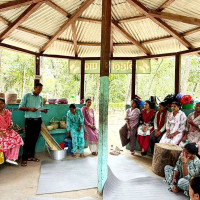- Saturday, 21 June 2025
Beyond the mat: Yoga’s holistic benefits
By Pallav Bhusal,Kathmandu, June 21: As thousands across Nepal roll out their yoga mats to mark International Yoga Day on Saturday, leading spiritual voices have cautioned against reducing the ancient practice to mere physical exercise, calling instead for a return to its holistic roots.
International Yoga Day, observed on June 21, is annually celebrated on the longest day of the year. In Nepal, yoga is far more than a physical discipline; it is part of the nation’s living tradition. Nepal is referred to as a spiritual hub globally, and it is a place where root of yoga practice run deep historically and culturally.
Yoga in its true form, according to experts, is a multi-dimensional discipline that encompasses ethics, breath, meditation, and inner awareness. Among them is Guru Ramesh Nepal, spiritual leader and co-founder of Jeevan Vigyan. He believes Nepal is at a crossroads in how it defines and promotes yoga.
“Yoga is not simply about postures. That is just one aspect of a much deeper system that begins with ethical living and ends with spiritual liberation,” said Nepal. “Without this understanding, we risk turning yoga into a performance, not a practice,” he added.
He explained that classical yoga, as described by Sage Patanjali, is made up of eight limbs, or Ashtanga: yama (ethics), niyama (self-discipline), asana (posture), pranayama (breath control), pratyahara (withdrawal of the senses), dharana (concentration), dhyana (meditation), and samadhi (absorption or union).
“Pranayama is where true yoga begins. Breath is the bridge between the body and the mind. When you gain control over the breath, you gain control over your thoughts, your reactions, and your health,” said Nepal.
Nepal’s natural and spiritual landscape makes it uniquely suited for authentic yoga practice. With its Himalayan backdrop, meditative traditions, and centuries-old spiritual centres, the country has the potential to become a global leader in yoga education.
“The world is looking for something real. Nepal doesn’t need to copy. We already have the roots, we just need to nourish them,” he said.
The origins of yoga go back to over 5,000 years to ancient Vedic practices, passed down through the wisdom of Himalayan sages. Nepal’s proximity to India allowed these teachings to flourish here, alongside Buddhism, which emerged in Lumbini in the 6th century BCE.
Patanjali’s codification of yoga into the eightfold path further strengthened Nepal’s spiritual ties, with sages like Gorakhnath meditating in caves across the country. These teachings remain a living legacy in Kathmandu and beyond.
Public events mark International Yoga Day nationwide, with hundreds gathering in parks and public venues.
See Page 6
Academic progress has also been made. Kathmandu University recently introduced an undergraduate programme in Yogic Science and Wellbeing, integrating traditional teachings with research in health, neuroscience, and psychology. Tribhuvan University launched a postgraduate diploma in Yoga Science in 2019, followed by a Master’s course in 2020. The government is also integrating yoga into school curricula, reinforcing the belief that Nepal can serve as the “Yoga Guru of the world.”
Nepal urged practitioners to go beyond the surface. “Yoga, in its truest sense, is the path to becoming a better human being. Even if you just sit and breathe mindfully for 10 minutes, that can be a more powerful form of yoga than doing twenty difficult poses,” he said.
“Yoga is not only physical. It unfolds in eight categories and is vital because it links the body to the breath, enabling inner stillness that unlocks the higher dimensions of yoga,” he added.
Nepal’s reputation as an authentic yoga destination continues to grow. Yoga practitioners praise the country’s spiritual legacy and call for protection of these traditions from commercial distortion.
According to yoga instructor Nabina L Giri, who is also Art of Living faculty, many people in Nepal are still unaware of yoga’s deeper meaning.
“Students often come in thinking it’s all about flexibility or fitness. But once they begin to learn about breathwork, meditation, and ethical living, they realise yoga is a tool for self-mastery, not just physical health,” she said.
She believes the rising interest in yoga among young Nepalis is promising, but more needs to be done at the grassroots level. “We need to teach yoga the way it was intended, not just as a class, but as a lifestyle.
That means more trained instructors, more education in schools, and more public awareness that yoga is not something foreign or trendy, it is
part of our own ancient identity,” she added.
As the world pauses to mark International Yoga Day, Nepal’s spiritual light shines bright. Not for gym-like demonstrations, but for its role in protecting the inward journey, from ethical grounding to breath mastery, concentration, and transcendence. As Guru Nepal reminded us, “Without pranayama and the inner limbs, yoga is but exercise.”







-square-thumb.jpg)

-original-thumb.jpg)




-original-thumb.jpg)